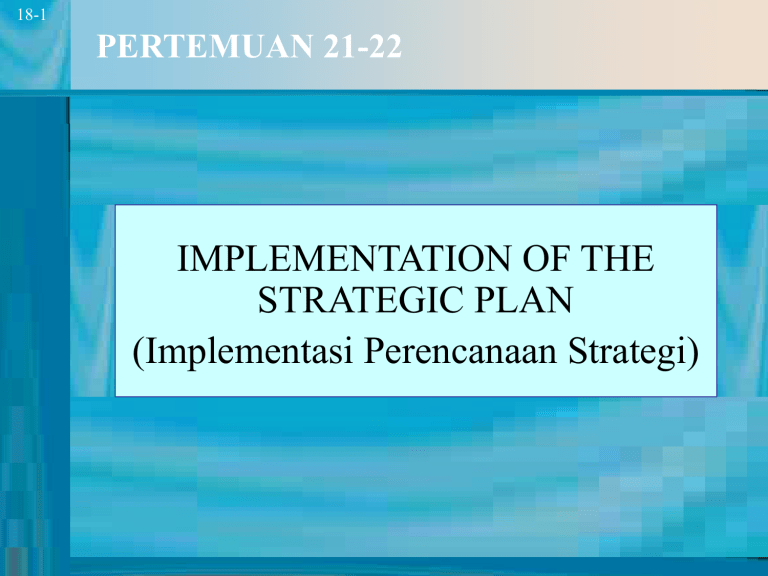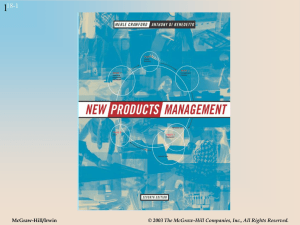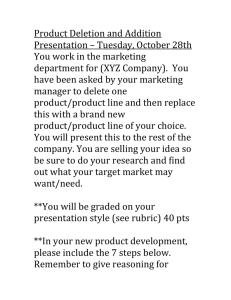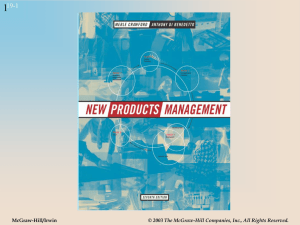IMPLEMENTATION OF THE STRATEGIC PLAN (Implementasi Perencanaan Strategi) PERTEMUAN 21-22

1 18-1
PERTEMUAN 21-22
IMPLEMENTATION OF THE
STRATEGIC PLAN
(Implementasi Perencanaan Strategi)
2 18-2
TIK
•
Mahasiswa mampu menghasilkan strategi launching produk baru.
3 18-3
Classic Product Life Cycle
•
Gambar 18.1
4 18-4
Sales and
Expenditures
The Launch Cycle
Figure 18-1
Sales
Expenditures
Prelaunch Beachhead
Announcement
Early growth
5 18-5
Launch Tactics
•
The Communications Plan
•
The Copy Strategy Statement
•
Personal Selling
6 18-6
Tactical Launch Decisions and Actions,
Showing Influences on Demand
Figure 18.2
Launch Tactic
Promotion
Advertising
Coupons
Publicity
Sampling
Beta Test Sites
Sales and Distribution
Shows/Demonstrations
Technical Support
Distribution Structure
Intensity of Coverage
Distribution Incentives
Pricing
Introductory Pricing
Price Administration
Product
Breadth of Assortment
Timing
Product Deletion
Preannouncing
Effective For:
Cases where awareness will stimulate trial
Reinforcing awareness
New and controversial technologies with high perceived usage risk
Cases where product advantages best learned through usage
Stimulating “sampling” and as a reference for other potential buyers
Clarifying relative product advantages or where uncertainty exists
Cases of incompatibility in usage process
Cases where relative advantage strong (direct channels)
Cases where warranty/maintenance service needs to be offered easily
Cases where availability needs to be stimulated
High relative advantage and compatibility (skimming policy); early adoption needs to be stimulated (penetration policy)
Cases where economic risk needs to be reduced (i.e., through rebates or money-back guarantees)
Introducing new product categories with high relative advantage
High margin but strong relative advantage (fast deletion); high switching costs (slow deletion)
Building hype for new products; useful if relative advantage is high
7 18-7
Preannouncement
•
Getting to be popular, and very creatively managed.
• Far from the old days of “tease the public.”
•
Preannouncement signaling may be used
(“vaporware”).
8 18-8
Beachhead
•
This refers to the heavy expenditure needed to overcome sales inertia (“getting the ball rolling”).
•
Steep rising expenditures curve during this period, up to point where sales are increasing at an increasing rate.
•
Begins with the announcement.
•
Key decision during beachhead: when do you end it? How do you know inertia has been overcome?
9 18-9
Copy Strategy Statement
•
Communications tools used at launch will have certain deliverables.
•
The way in which the firm communicates these deliverables to the advertising and promotion creative people is the copy strategy statement.
•
Typical contents:
–
The market segment targeted
–
The product positioning statement
–
The communications (promotion) mix
–
The major copy points to be communicated.
Typical Examples of Copy Points
• “The provider of this insurance policy is the largest in the world.”
• “This cellular phone has no geographic limitation.”
• “Dockers are available at JCPenney.”
• “Future neurosurgeons benefit from the handto-eye skills of computer games like this one.”
There is no limit to the choices here, but there must be a focus. Only a few copy points are going to be accomplished at a time.
A-T-A-R Goals: The New Product Group’s
Obligation
•
New product group must persuade itself and management that the plan can achieve the necessary awareness, availability, trial, and repeat purchase...
• and that it can do so in sufficient quantity and at acceptable cost.
Awareness
•
Measuring Awareness
•
Methods for Getting Awareness
Motivating Distributors
Figure 18-3
• Increase distributor’s unit volume.
• Increase distributor’s unit margin.
• Reduce distributor’s cost of doing business.
• Change distributor’s attitude toward the line.
Alternative Tools and Devices for Motivating
Distributors
•
Gambar 18.3
Barriers to Trial
• Lack of interest in the claim.
•
Lack of belief in the claim.
• Rejecting something negative about product.
•
Complacency.
• Competitive ties.
•
Doubts about trial.
•
Lack of usage opportunity.
•
Cost.
• Routines.
•
Risk of rejection.
Appropriate Launch Tactics Given Relative
Advantage and Compatibility
Figure 18.4
1. Low Compatibility
2. High Compatibility
A. Low Relative Advantage
Penetration price
Slow deletion
Risk-based promotion (leasing, money-back guarantees, equipment allowances)
Intensive distribution
Secrecy before entry
Narrow product assortments
Awareness promotion (coupons, etc.)
Intensive distribution
B. High Relative Advantage
Preannounce
Broad product assortments
Information-based promotion
(shows, demonstrations, websites, publicity/education)
Selective distribution
Skim price
Fast deletion
Usage-based promotion (samples, beta tests) to clarify benefits received
Selective distribution
Source: Adapted from Joseph P. Guiltinan, "Launch Strategy, Launch Tactics, and Demand Outcomes,"
Journal of Product Innovation Management , Vol. 16, No. 6, November 1999, pp. 520-521.
Summary
…..




